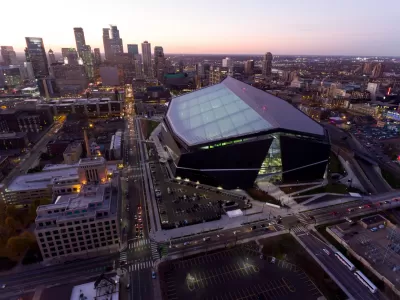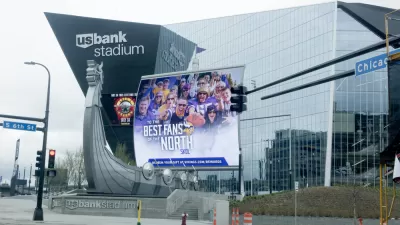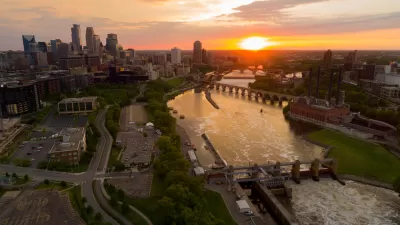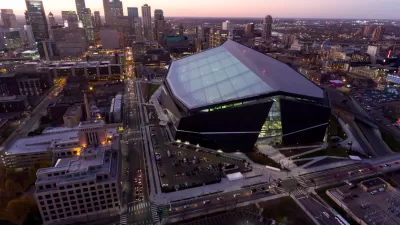Urbanists and planners might consider looking at the development outside U.S. Bank Stadium in Minneapolis on Super Bowl Sunday. Gone are the vast parking lots surrounding the Metrodome, replaced with mixed use and a popular park, the Commons.

"[F]ootball fans returning to the city to watch the New England Patriots and Philadelphia Eagles compete in Super Bowl LII on Feb. 4 are not likely to recognize the area, now known as East Town [formerly Downtown East or East Downtown]," writes freelance journalist, Joe Gose, in the Square Feet column of The New York Times on Jan. 23.
The Metrodome, a walled-in colossus that dominated the barren landscape from 1982 to 2014, has been replaced by U.S. Bank Stadium, which opened in 2016. The roughly $1.1 billion bright and transparent edifice, designed by HKS architects, features a mostly clear, steep roof and has been likened to a Nordic long house, a Viking warship and an ice shard formation.
New offices, apartments, hotels, restaurants and a 4.2-acre park known as the Commons have replaced the parking lots. In all, more than $2 billion in private and public investment has been injected into East Town, according to the East Town Business Partnership, an organization that promotes the roughly 120-block district, which is bordered generally by the Mississippi River, downtown and three interstates.
About five of the original 15 blocks of parking lots still remain, said George Sherman, principal of Sherman Associates, a developer in East Town. “I doubt if there will be any that haven’t been developed in the next two to three years.”
Over half of the original $975 million cost of the stadium came from of state and city funds. Opponents pointed to Metrodome's failure to generate economic development, a reason in itself to avoid providing plentiful parking for stadium events.
The Commons park played a prominent role in encouraging developers to invest in the area.
“When we first looked at the opportunity, we thought there was too much land — there was going to be a great new stadium, but there was nothing to prevent the area from being another sea of surface parking,” said developer Mike Ryan. “But having a major public green space at its core is the reason developers want to be there.”
As for Minneapolis reaping an economic windfall from the game, "economists say its overstated," writes Kevin Draper, a sports business reporter for The New York Times, on Jan. 29.
Getting to the game
East Town and the stadium are served directly by Metro Transit's Blue and Green light rail lines and bus lines, with connecting light rail service from Northstar Commuter Rail. "Ticket holders who buy a $30 'game day' pass will get a nonstop [light rail] ride from a security screening area directly to U.S. Bank Stadium for the game," wrote Sam Newberg, a Minneapolis-based urbanist and Planetizen contributor, on Nov. 19, 2017.
For more reading in Planetizen on the East Town development, see:
-
April 16, 2015, Minneapolis Star TribuneA new park and lots of new development will follow the under-construction stadium for the Vikings on the eastern side of Minneapolis urban core.
-
June 1, 2013, Minneapolis Star TribuneDevelopers have announced plans for 'one of the largest real estate projects in Minneapolis history.' The ambitious proposal for a five block area in the city's downtown east neighborhood could be a catalyst to transform the 'largely barren' area.
FULL STORY: Super Bowl’s Minneapolis Stadium Brings a Surge in Development

Study: Maui’s Plan to Convert Vacation Rentals to Long-Term Housing Could Cause Nearly $1 Billion Economic Loss
The plan would reduce visitor accommodation by 25,% resulting in 1,900 jobs lost.

North Texas Transit Leaders Tout Benefits of TOD for Growing Region
At a summit focused on transit-oriented development, policymakers discussed how North Texas’ expanded light rail system can serve as a tool for economic growth.

Alabama: Trump Terminates Settlements for Black Communities Harmed By Raw Sewage
Trump deemed the landmark civil rights agreement “illegal DEI and environmental justice policy.”

How Community Science Connects People, Parks, and Biodiversity
Community science engages people of all backgrounds in documenting local biodiversity, strengthening connections to nature, and contributing to global efforts like the City Nature Challenge to build a more inclusive and resilient future.

Alabama: Trump Terminates Settlements for Black Communities Harmed By Raw Sewage
Trump deemed the landmark civil rights agreement “illegal DEI and environmental justice policy.”

Dear Tesla Driver: “It’s not You, It’s Him.”
Amidst a booming bumper sticker industry, one writer offers solace to those asking, “Does this car make me look fascist?”
Urban Design for Planners 1: Software Tools
This six-course series explores essential urban design concepts using open source software and equips planners with the tools they need to participate fully in the urban design process.
Planning for Universal Design
Learn the tools for implementing Universal Design in planning regulations.
City of Santa Clarita
Ascent Environmental
Institute for Housing and Urban Development Studies (IHS)
City of Grandview
Harvard GSD Executive Education
Toledo-Lucas County Plan Commissions
Salt Lake City
NYU Wagner Graduate School of Public Service





























